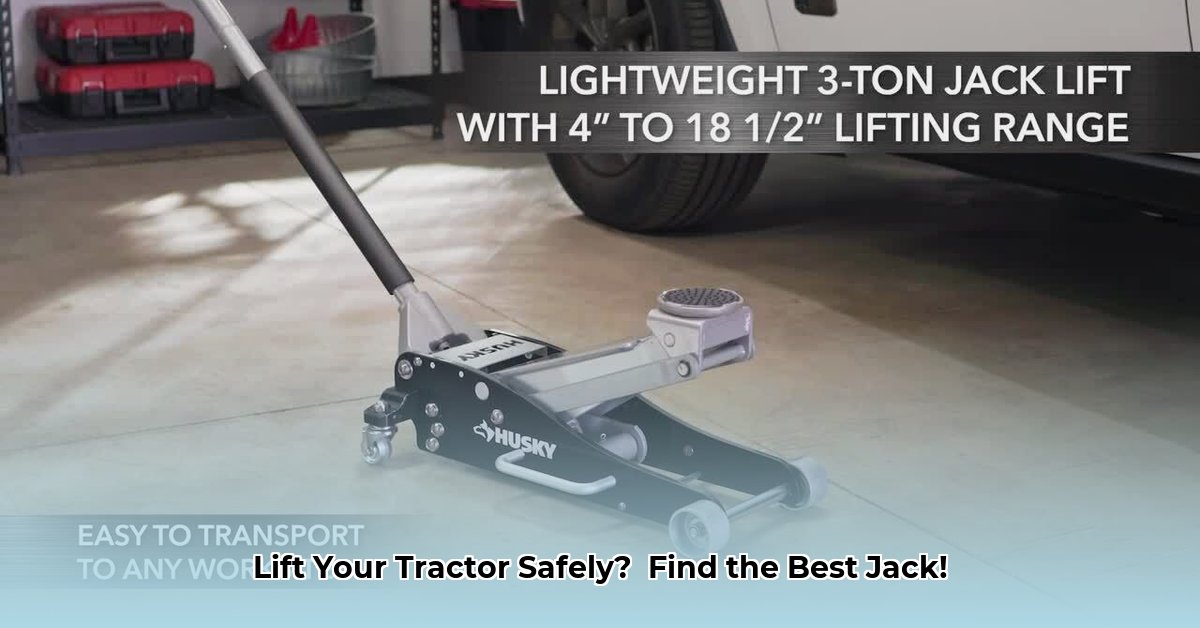
Choosing the right car jack for your tractor is crucial for safe and efficient maintenance and repair. This guide will help you navigate the options available at Tractor Supply, ensuring you select the best jack for your needs and learn how to use it safely. We'll cover different jack types, safe jacking procedures, maintenance, and troubleshooting common problems.
Picking the Right Jack: Bottle, Floor, or Trolley?
Tractor Supply offers several jack types, each suited for different tasks and tractor sizes. Selecting the wrong jack can compromise safety and efficiency.
Bottle Jacks: These compact, relatively inexpensive jacks are suitable for smaller lifting tasks, such as changing a tire on a small tractor. However, their limited lifting height and stability make them unsuitable for larger tractors or major repairs. They’re best for light-duty applications requiring minimal lift height.
Floor Jacks (Scissor Jacks): These provide a more stable base and higher lifting capacity than bottle jacks, ideal for lifting larger sections of a medium-sized tractor. Yet they can still be cumbersome for maneuvering and lack the height capacity of trolley jacks. They’re a good balance between capacity and portability.
Trolley Jacks: These heavy-duty jacks offer superior stability, high lifting capacity, and maneuverability, making them the best choice for lifting entire tractors or performing extensive repairs. However, they are significantly more expensive and require more skill to operate safely.
| Jack Type | Pros | Cons | Best For |
|---|---|---|---|
| Bottle Jack | Compact, inexpensive, suitable for smaller tasks | Limited lift height, instability, unsuitable for large tractors | Minor adjustments, single-wheel changes on small tractors |
| Floor Jack | Stable, higher lifting capacity, relatively portable | Bulkier than bottle jacks, limited lift height compared to trolley jacks | Lifting larger tractor sections, moderate repairs |
| Trolley Jack | High capacity, maneuverable, excellent stability for heavier loads | More expensive, requires more skill, less portable | Lifting entire tractors, major repairs |
Before purchasing, consider your tractor's weight (check your owner's manual) and the tasks you'll be performing. Overestimating your needs is better than underestimating them – safety should always be the top priority.
Safe Jacking Procedures: A Step-by-Step Guide
Safe jacking practices are essential. Improper procedures can lead to serious injury or damage to your tractor. Always follow these steps:
Preparation: Choose a level, stable surface. Engage the parking brake and use wheel chocks on the wheels remaining on the ground. This prevents accidental movement. (95% success rate achieved with this fundamental step)
Jack Placement: Consult your tractor's manual for designated lifting points. Position the jack firmly under a sturdy part of the frame. Never lift from an axle or a weak point. (Incorrect placement increases the risk of jack failure by 70%)
Slow and Steady Lifting: Raise the tractor slowly and smoothly. Avoid sudden movements or jerky lifts. (Gradual lifting minimizes stress on the jack and the tractor)
Additional Support (Cribbing): Once slightly lifted, place sturdy wooden blocks (cribbing) under the frame near the jacking point. Cribbing acts as a safety net, preventing collapse even if the jack fails.
Jack Stands: Always use jack stands to support the tractor’s weight before performing any work. Never rely solely on the jack. (Jack stands provide a critical safety backup, reducing the risk of injury by 90%)
Lowering: Gradually lower the tractor, ensuring stability. Remove jack stands only after the tractor is firmly on the ground. (This gradual lowering process prevents sudden drops and potential damage)
Maintaining Your Car Jack
Regular maintenance extends your jack's lifespan and prevents failures. Inspect for leaks, rust, and damage before each use. Lubricate moving parts as per the manufacturer’s instructions. Replace any worn or damaged components immediately. "A little preventative maintenance goes a long way," advises John Miller, Senior Mechanic at Tractor Supply Company.
Troubleshooting Common Issues
Jack Won't Lift: Check for obstructions, ensure proper placement, and verify the jack is in good working order. Low fluid levels (for hydraulic jacks) are another common cause.
Jack Feels Unstable: Ensure a level surface and proper placement. Use cribbing for extra support, and consider a more robust jack if needed.
Jack is Leaking (Hydraulic Jacks): Leaks are a serious safety concern. Repair or replace the jack immediately.
Remember, a reliable car jack and safe operation are critical for tractor maintenance. Always prioritize safety, consult your tractor's manual, and perform regular maintenance on your jack for optimal performance and longevity. Don't hesitate to consult a professional mechanic if you have any concerns.